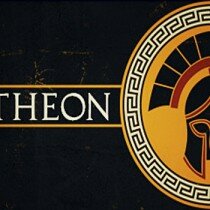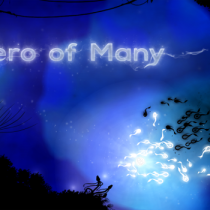Having garnered something of a reputation for himself in the still-fledgling computer gaming market, Richard Garriott found himself in an unenviable position: how to follow Akalabeth: World of Doom. While not the most sophisticated or visually stunning game made up to that point, Akalabeth was, as detailed in my article on the game, a game of considerable character and charm, one that had caught the imagination of many of the new group of people soon to be called Gamers.
The question for Garriott was this; how should he follow up on Akalabeth? While an interesting premise, the game’s narrative was in all intents and purposes a thinly veiled mechanic for setting up one level after another. Was this the mechanic he should follow again for his next title?
That question was answered in September 1980, when Ultima I (later to retrospectively be known as Ultima I: The First Age of Darkness) was presented to the world. Now considered by many to be the first commercial RPG game, Ultima I changed the face of gaming as we know it. Gone was the linear level structure of Akalabeth. Gone was the small-scale quest to become a knight. In their place was left a (relatively) open world adventure on a never-before-seen scale. In today’s saturated gaming market, it’s hard to fully appreciate the sea-change this was for the budding gaming market. Today, many games are sold on the fact they are open-world games alone. In 1980, this was something that was virtually unique. It can be argued that the release of Ultima one was the first shoot of what would blossom into the RPG genre we have today.

The first commercial RPG?
Yes, when you actually look at it, the ‘open-world’ aspect of the game is something of an illusion, a perception created to bring a sense of scale, essentially a more sophisticated version of the Lord British quest mechanic from Akalabeth, but in a sense the perception was more important than the application. This really felt like a world that you experienced and influenced, rather than a set script you had to follow and that was completely different from what came before.
What added to this, and further distanced the game from others at the time, was the application of a central narrative. The game, as with Akalabeth, bears the hallmark of Tolkien-esque narrative structure, lending a grander sense of scale to the proceedings than perhaps they really deserve. The story, in itself is a fairly basic one, with the wizard Mondain having created a Gem of Immortality which he is now using to terrorise the land of Sosaria, in which the game is set. Lord British recruits the player to find a way of defeating Mondain.
Now that’s all very well, but what did the game actually consist of? What did the game present you to occupy your attention in this fabulous world? Well, that’s the main oddity of Ultima I. In essence, all you’re really doing is a similar set of arbitrary quests as in Akalabeth. The game world of Sosaria has 8 Lords ruling areas of the kingdom and each Lord (of which Lord British is one) has 2 quests for you to complete; one for a stat boost and one for an important item. In this aspect more than any other the links to Akalabeth as most pronounced.
So far so standard right? Yes, but what really differentiates Ultima I from its predecessor (and previous gaming titles period) is what begins in the latter half of the game. The method of defeating Mondain is to create a time machine and travel back in time to kill Mondain before he creates the Gem of Immortality. The incorporation of Science-Fiction aspects into a traditional fantasy setting was, at the time, somewhat unusual and striking in and of itself. The way this was incorporated into the game was simply glorious. Part of the process of acquiring the Time Machine is to fly a shuttle (made by a village blacksmith mark you) into space and do galactic battle with what look suspiciously like Tie-Fighters.
Just take a moment to re-read that part, go on, I’ll wait….

The dungeons retain first-person pespective
I know right? Is that not the most fantastic premise you’ve come across? When playing Ultima I for the first time, I think every gamer has a moment where they just stop and reflect on the sheer absurdity of what they are doing in game. This, above all else, is what makes Ultima I so memorable as a game.
The game does, of course, bear many hallmarks of an early Richard Garriott title. The game continues with the requirement for food to be carried at all times, again as distance limiter. Along with this, when flying in space you have to make sure you have enough fuel to get to where you are going and back. Run out of either and you’re dead. Indeed, sudden ignominious death would be a persistent theme of the early Ultima games. Hell, in Ultima I if you try and fly to space without power armour you die of de-pressurisation. No hints, no warnings, just splat – game over. You don’t get harsh gaming lessons like that anymore people.
The game itself is notable for the first appearances of several series stalwarts. Future companions Iolo (pronounced Jo-Lo by the way) and Shamino (fun fact: anyone who knows my internet moniker, as shown on my profile page on the website, will see how much Ultima means to me) make appearances in the game, as does chuckles the jester and, of course, Lord British also makes a return from Akalabeth.
Many themes from Ultima I continue through various other games in the series, with some, such as the sci-fi elements, dwindling fairly soon and others, such as the dungeon crawling, remaining a staple throughout.

Floppy Discs baby, that’s were its at!
As with Akalabeth: World of Doom, Ultima I is by no means a great technical showpiece. In many ways, it stands as an example of things that shouldn’t work. Sci-fi in a fantasy setting shouldn’t work and an antagonist who starts the game having essentially won shouldn’t work either. But we should all be thankful that they somehow do in Ultima I. It’s hard to quantify how important and influential Ultima I was and, by extension, continues to be in the gaming industry. If the game had bombed, if the disparate themes hadn’t worked, the series would have died right there. Now, it’s always hard to say things like ‘without X you wouldn’t have Y’ but I genuinely believe that while without Ultima I you may still have had games like Final Fantasy and Fallout, those games would probably have been very different and arrived much, much later. Ultima I was a gateway game, in the sense that it opened the door for future RPGs; it created the concept and formula from which future games drew their standard and introduced the public and industry together to the idea of an interactive story game in which the player played a distinct role.
For this reason alone Ultima I is one of the most important and influential games to have ever been put to code. So just think, next time you’re swinging an axe in Skyrim or firing a rifle in Mass Effect, think back to Ultima I, of how far we’ve come and how lucky we are that Ultima I came to be.
Next time, I take a trip in my Blacksmith-built space shuttle and blast off to the world of Ultima II: Revenge of the Enchantress! Join me won’t you?
© 2013 – 2015, zero1gaming.com. All rights reserved. On republishing this article your must provide a link to this original post
About Paul Izod
Paul Izod is a lifelong gamer. Since he was old enough to tap at his Dad's PC's keyboard he's been a gamer. Dedicated and often opinionated, you can be sure he'll always have something interesting to say about the subject at hand. Find him on Twitter at or or email him at
•




